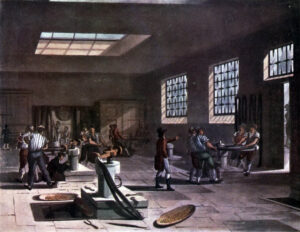In January 1799, Colonel William Fullarton – a Scottish politician and, between 1779 and 1803, a member of the House of Commons – wrote a letter to his trusted London coin dealer. He contacted Matthew Young regarding the production of silver coins on behalf of an unspecified company. The Prince of Wales, who – according to Fullarton – had as High Steward of Scotland the authority to transfer the Scottish privilege of minting coins to others, was to grant the authorisation for the undertaking. Therefore, Fullarton wrote, Matthew Young should urge John Milton, the medallist commissioned to produce the coins, “to execute a die for a Shilling Coin – [that shows] on one side, the Head of the Prince of Wales, and round the head, these words, Georgius G.P.S.S.C.D. – 1799. On the other side, Engravings of the Arms, and the Emblems of the Prince of Wales, in four compartments, such as those of the Mint Shillings of George 2nd or George 3rd, taking particular care that nothing be engraved which can interfere with the Arms and Emblems of His Majesty.” On the reverse he wanted the inscription “Regni Scotiae Senescallus” to be engraved as the title of the Prince of Wales in order to identify him as the High Steward of the Kingdom of Scotland, since he was the one to authorise the mintage – or at least that was what Fullarton hoped for.

One result of this trial mintage, a 6 pence off-metal strike in gold, will be sold on 10 October 2019 at auction house Künker in Osnabrück. The estimate is 10,000 euros. It is extremely rare because the actual mintage was never carried out. Sir Joseph Banks, who had been a grey eminence of the London society since he circumnavigated the globe together with James Cook, exerted his influence to prevent this – a reason for that was probably his friendship to the involved medallist John Milton.

Only two years earlier, John Milton had been involved in a scandal that could have ended badly for him: The third engraver of the Royal Mint, whose salary of 80 pounds a year was rather poor, had supplied his colleagues with dies for the production of foreign coins – among them French gold coins –, which had been produced (counterfeited?) at the Royal Mint of London, and all the involved parties earned a lot of money with it.
Coin counterfeiting at the Royal Mint? Shocking! Not only the politicians did realise how much the ethos of the people working at the Royal Mint suffered because of the outdated mint that was barely used. The demoralised craftsmen had far too much spare time and used it to come up with this idea, for there was no law in Great Britain that prohibited the production of foreign coins. In 1796/7, also the Treasury discovered this fact by conducting harsh inquiries and losing two lawsuits. All those involved remained unpunished, including Milton, who at least lost his position as third engraver (and who was of the opinion that this was highly unfair). It was not until July 1797 that a law was enacted which officially made the counterfeiting of foreign coins in Great Britain punishable.
Since then, Milton has worked once again as an engraver of gems for signet rings. Occasionally, he was commissioned to produce dies for medals. In those cases, it was usually Sir Joseph Banks who recommended him to the customers because he was sympathetic to Milton.
When Banks found out about Fullarton’s intentions to mint private coins in the name of the Prince of Wales, he advised Milton not to participate in this venture. According to him, it was common knowledge that only the Crown had the privilege to mint coins. Fullarton was of a different opinion. He had a legal opinion drawn up that came to the following conclusion: “Anyone has the right to issue coins, even coins made of silver, as long as they are called tokens and are no imitations of or have similarities with the current circulation coins of His Majesty.” Therefore, Milton did still finish the dies for the trial minting of the Fullarton tokens.

However, the scandal in the mint had led to a shift in thinking on the part of the legislator. In 1798, a commission was instituted in order to modernise the monetary system of Great Britain. It gave the order to build the Tower Hill Mint: Back then, it was the most modern mint of the world.
In the 19th century, the private Birmingham Mint produced legally and with great success coins for other states.
And here you can read a complete auction preview.



